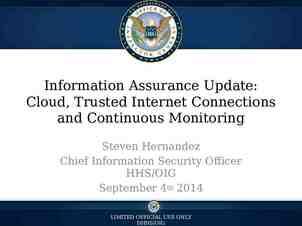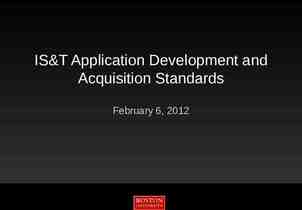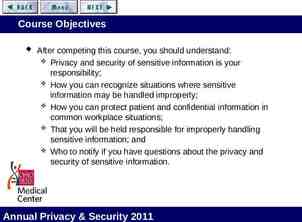Protective Security Advisors “Securing the Nation’s critical
27 Slides5.50 MB

Protective Security Advisors “Securing the Nation’s critical infrastructure one community at a time”

Preparedness Directorate Under Secretary Preparedness (George Foresman) National Preparedness Task Force (Corey Gruber) Fire Administration (Charlie Dickinson) Grants and Training (Tracy Henke) Chief Medical Officer (Dr. Jeff Runge) Cyber Security & Telecommunications (CS&T) (Greg Garcia) Office of Infrastructure Protection (IP) (Bob Stephan) National Capital Region Coordination (Tom Lockwood)

DHS IP Organization Office of Infrastructure Protection (IP) Homeland Infrastructure Threat & Risk Analysis Center (HITRAC) Contingency Planning and Support Division (CPSD) IP Incident Management Cell (IP IMC) Risk Management Division (RMD) Protective Security Advisors (PSA) Chemical and Nuclear Preparedness Protection Division (CNPPD) Infrastructure Partnerships Division (IPD) National Infrastructure Coordinating Center (NICC)

Communities Depend Daily on Reliable Systems These systems are the “invisible” critical infrastructure that our communities depend on every day, for example: Telephone systems that allow us to use ATMs/credit cards for our financial transactions, and real-time communications for business and personal use (cellular phones, pagers, e-mail, land-lines, and faxes) Electricity that allows us to light and heat our homes and businesses, and power computers and vital communication devices like radio and television Water systems that provide us with water for drinking, sanitary needs, irrigation, and firefighting capabilities

Critical Infrastructure & Key Resource Sectors Critical Infrastructure Sectors Agriculture and Food Key Resources Banking and Finance Chemical Defense Industrial Base Drinking Water and Wastewater Treatment Systems Emergency Services Energy Information Technology National Monuments and Icons Postal and Shipping Public Health and Healthcare Telecommunications Transportation Systems Commercial Facilities Commercial Nuclear Reactors, Materials, and Waste Dams Government Facilities

The Threat We will “hit hard the American economy at its heart and its core.” - Osama bin Laden Without doubt, terrorist groups recognize the economic ramifications of attacks on the Nation’s critical infrastructure and key resources.

Dependency on our Critical Infrastructure & Key Resources National Security Economic Vitality Our Way of Life Attacks Could Disrupt government and private industry operations and impact our economy and society Result in large-scale human casualties, property destruction, and damage to national prestige and public confidence

The Role of the Department of Homeland Security Unify a national effort to secure America Prevent and deter terrorist attacks Protect against and respond to threats and hazards to the Nation Respond to and recover from acts of terrorism, natural disasters, or other emergencies Coordinate the protection of our Nation’s critical infrastructure and key resources (CI/KR) across all sectors

The Challenge to Protect Critical Infrastructure & Key Resources 85% of all CI/KR assets are privately-owned The Department of Homeland Security must work with industry and Federal entities, as well as state, territorial, local, and tribal governments to protect CI/KR To help communities better protect the Nation’s assets, the Department of Homeland Security is placing Protective Security Advisors (PSAs) in metropolitan areas throughout the country

PSA Districts

The Department of Homeland Security Provides Community-Based Support Protective Security Advisors will: Assist with ongoing local and state critical infrastructure security efforts which are coordinated by the state Homeland Security Advisors Support the development of the national risk picture by identifying, assessing, monitoring, and minimizing risk to critical assets at the local level Upon request, facilitate and coordinate vulnerability assessments of local CI/KR Provide reach-back capability to the Department of Homeland Security and other Federal government resources

Protective Security Advisors Will Also Assist in verification of critical asset information for accurate inclusion into the National Asset Database Serve as advisors regarding local infrastructure during activation of the National Response Plan Provide local context and expertise to the Department of Homeland Security to ensure that community resources are used effectively Facilitate the flow of programmatic information between all parties with a vested interest in CI/KR protection Work in state and local Emergency Operations Centers to provide expertise and support to the IP Infrastructure Liaison Cell, who supports the Principal Federal Official and Federal Coordinating Officer responsible for domestic incident management

Protective Security Advisors’ Sector Coverage Although the Risk Management Division (RMD) has Sector-Specific Agency responsibility for Commercial Facilities and Dams, PSAs cover all 17 CI/KR sectors.

Value of the Program to You Protective Security Advisors will: Support comprehensive risk analyses of local CI/KR Assist in the review and analysis of physical/technical security of local CI/KR Convey local concerns and sensitivities to the Department of Homeland Security and other Federal agencies Relay disconnects between local, regional, and national protection activities Communicate requests for Federal training and exercises

Your PSA Can Also Give guidance on established practices Provide local communities with access to updated Department of Homeland Security capabilities, including: – New tools and technologies – Best practices for protection and mitigation strategies – Expertise and experience within the Department of Homeland Security and other agencies – Expertise and experience from other PSAs based in communities with similar concerns Keep communities informed of national policy context and initiatives Provide support to officials responsible for special events planning

PSA Activity To Date Includes. . . Establishing relationships with 8,000 stakeholders on the Federal, state, territorial, local, and tribal level and within the private sector (since 14 March 2005) Supporting risk reduction activities, including the facilitation of Site Assistance Visits, the Buffer Zone Protection Program, as well as verification and technical assistance visits to CI/KR Attending numerous conferences and participating in large exercises and special events throughout the country

PSA Activity Also Includes. . . Providing real-time situational awareness to the Department of Homeland Security/RMD leadership on incidents or areas of concern Supporting the response, recovery, and reconstitution efforts of those states affected by Hurricanes Katrina and Rita by: – Working with Principal Federal Officials and Federal Coordinating Officers in states’ Joint Field Offices – Supporting representatives tasked to coordinate Emergency Support Functions of the National Response Plan – Helping to coordinate Federal, state, and local law enforcement efforts regarding the protection of CI/KR – Performing site visits for general damage and security assessments in coordination with RMD deployed teams – Providing advice on protective measures

IP Incident Management Support to the Joint Field Office

Infrastructure Liaison Principal advisor to the JFO Coordination Group regarding all national and regional CI/KR incident-related issues Senior IP representative in the JFO and its area of operations

Infrastructure Liaison Responsibilities include the following : – Serve as the senior advocate within the JFO for CI/KR issues and support the prioritization of protection and restoration efforts – Liaison between the national-and regional-level CI/KR, the private sector, and the JFO – Provide situational awareness on the affected CI/KR to the JFO Coordination Group – Coordinate action on CI/KR and ESF issues between the JFO Coordination Group and IP representatives located at critical operations centers including the NOC, the NICC, and the NRCC in coordination with the IP Incident Management Cell (IP IMC) – Reach back through the IP IMC to resources available through IP Headquarters and the IP Divisions

Baseline Infrastructure Liaison Cell JFO Coordination Group Principal Federal Official IP IMC Infrastructure Liaison JFO Coordination Staff Deputy Infrastructure Liaison JFO Operations Section Federal Coordinating Officer (Reach back) JFO Planning Section Situation Cell Specified Geographic Branch AFO PSA Supervisor IP Action Officer IP Master Watch Control Log Operator Key State EOC PSA Area AreaField FieldOffice Office Area Field Office (as required) Area Field Office (as required) (as PSArequired) IP Staff Note: IP staffing levels, e.g., single or double shifts and Area Field Office support are driven by JFO operational requirements JFO Staff

IP Support to the Gulf Coast PFO Gulf Coast JFO Coordination Group Principal Federal Official Federal Coordinating Officer Gulf Coast JFO Coordination Staff Infrastructure Liaison (Gulf Coast) MS LA LA AL Mississippi JFO Louisiana JFO Alabama JFO Federal Coordinating Officer (MS) Federal Coordinating Officer (LA) Federal Coordinating Officer (AL) Infrastructure Liaison (MS) Infrastructure Liaison (LA) Infrastructure Liaison (AL) Infrastructure Liaison Cell Infrastructure Liaison Cell Infrastructure Liaison Cell Note: IP staffing levels are driven by JFO operational requirements

IP Incident Management Locations NICC Herndon, VA IP IMC and IP NOC Watch DHS HQs IP NRCC Liaison FEMA HQs PSA @ LA EOC Legend Steady State Incident Management (as required) Infrastructure Liaison @ JFO, Baton Rouge, LA Area Field Offices (as required)

IP Support to other NRP Structures National Operations Center (NOC) – IP Watch Desk Domestic Readiness Group (DRG) Representative National Response Coordination Center (NRCC) – IP deploys an Infrastructure Coordinator to the NRCC to support incident management – Currently discussing full time IP representation with FEMA HQs

National Infrastructure Simulation and Analysis Center (NISAC) Support Pre-Season Hurricane Swath Analysis – – – – – – – New York City Metro Area Category 3 Storm Mid-Atlantic Area Category 4 Storm Miami/Dade County Area Category 5 Storm Tampa Bay Area Category 4 Storm Mobile Area Category 4 Storm Houston/Galveston Area Category 4 Storm New Orleans Area Category 5 Storm Post-Landfall Assessments to identify restoration priorities based on analysis of damage assessments -intended to expedite real-time analysis Posted to the HSIN for user access

Hurricane Fast Response Process Data National Hurricane Center: Storm data Flood maps Storm surge Infrastructure Information (asset locations, capacities, etc.) Regional/temporal specific conditions and issues Infrastructure Modeling, Simulation, and Analyses Infrastructure outage/restoration Assets/capacity outaged Economic Impacts Sector-specific impacts Dependency and Interdependency Analyses Consequence Assessment National, regional, local impacts Short and Long term impacts Impacts of infrastructure disruptions Commodity flow / supply chains







